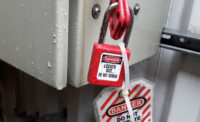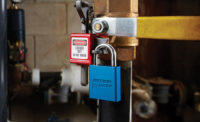Each year when OSHA reports its most frequently violated standards, the control of hazardous energy, also known as lockout tagout (1910.147) consistently appears high on the list of greatest offenders. In fact, despite the immense danger to machine operators and workers, citations for improper lockout tagout procedures ranked fifth on OSHA’s 2018 top 10 most frequently cited standards list, with nearly 3,000 violations.
Lockout tagout is a procedure that is used across industries, including manufacturing, utilities, medical facilities, food service and research settings, to help guarantee machinery is deenergized or shut down while maintenance is being performed. In order to prioritize the safety of employees, the energy is isolated to prevent accidental startup, as well as possible injuries to anyone working on the machine. Most business operators agree that a lockout tagout program is an ideal way to keep employees safe and is a smart policy to implement, but often find it is not as easy to put into practice. In reality, business owners and safety managers can execute a successful lockout tagout program with three simple steps; drafting a formal policy, purchasing quality equipment and training employees on procedure.
Write it down
It is important for any company beginning a lockout tagout program to first create a written document detailing all of the features of the program to employees. The document should include step-by-step procedures for all equipment that needs to be deenergized, including how to shut down each machine, how to control the hazardous energy and how to apply lockout tagout devices. Photos and diagrams can be helpful to confirm all information is easily digestible to a variety of audiences. For companies that do not know where to begin, templates are available to help them get started, although it is recommended that written programs are tailored to a company’s own specific needs.
Durable, quality signage
After plans and procedures are drafted, companies should spend time ensuring they are purchasing the best quality and durable tags available. There are many different products available when it comes to lockout tags, including rigid vinyl with brass or plastic grommets. Make sure to not purchase brass if there is any chance of conductive electricity. It is important that companies consider the tensile strength of the tag, to ensure it is strong enough to hold the tag in place so it cannot be easily pulled off. Certain industries, like utilities, may need to specify certain tensile strength requirements for safety tags to their provider. Finding a reputable industrial and safety signage partner can help take the guesswork out of what is needed to meet these requirements. Make sure you work with a company that can adhere to any specific customizations.
Foster a culture of safety
One type of lockout product that can help foster a culture of safety in your organization is a lockout tagout station. This station not only organizes locks and tags, but its very presence serves as a visual reminder to employees that they need to lockout a machine prior to servicing for maintenance. Many companies find that having these lockout stations helps eliminate employees’ temptation to work without adhering to safety guidelines. Another visual reminder for employees is customized and personalized tags for each worker. While it is regulation for all tags to provide identification for the person performing the lockout, some providers offer the capability of personalizing IDs with photos. Looking at the photo of the worker performing maintenance can also give pause for an employee considering energizing the machine before it is safe to do so.
Companies need to make sure that as they purchase locks, tags and materials, that they are considering all types of machines and all types of maintenance. For example, for machines that require a team to perform maintenance, it’s advisable to work with a provider who offers different devices for group lockouts. A good partner will walk its clients through all of the necessary items.
The significance of training
Once a written plan is in place and the lockout materials have been acquired, it is vital for a company to train employees to participate in the program and use the materials. Training should include reviewing the written program and reviewing the OSHA requirements. Companies can consult OSHA requirements, the National Safety Council’s training programs, and safety professionals to create equipment-specific training for all authorized and affected employees. It is also advisable that companies work with a third-party safety professional to assist with auditing lockout tagout programs to identify stop gaps.
Lockout tagout programs serve a critical, lifesaving purpose while also ensuring machinery is properly maintained at regular intervals, and that no damage comes to equipment if it is energized too early. Companies with an established program of procedures to control energy will also be in compliance with OSHA requirements, including the standards outlined in 29 CFR 1910.147.
But, of course the most important reason for implementing a lockout tagout program is to ensure that each and every employee returns home safely at the end of each day. When hazardous energy is not properly contained and controlled, workers can sustain serious or fatal injuries. And according to OSHA, employees exposed to hazardous energy lose an average of 24 workdays. Keep your workers safe and eliminate lost work accidents by creating your lockout tagout program today.






